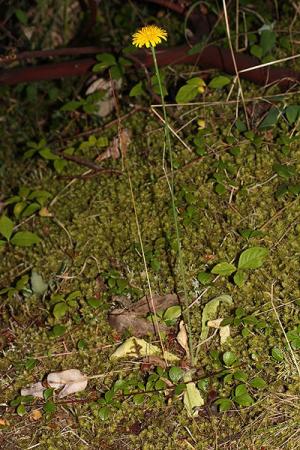Catsear

Hypochaeris radicata (syn. Hypochoeris radicata), is probably one of the most widely distributed weeds in the world. As a result the plant goes by a variety of names depending upon the country and region in which it is located. Names include flatweed, rough cat's ear, hairy cat's ear, catsear, common cat's-ear, spotted catsear, false dandelion, frogbit, and gosmore. The most common name being some derivative of cat’s ear in reference to the softly lobed hairy leaves which somewhat resemble the ears of a cat. In North America, the plant can be found throughout the United States and much of Canada, where it is considered to be a widely distributed invasive weed. In appearance, to all but the trained eye this plant resembles the common dandelion in both overall appearance and color; differences being stem length, leaf hair and serration.
As is the case with many other plants, toxic effects may be species dependent. Whether this is a result of size differences, or differences in physiological factors between species is unknown. There is no documentation regarding the toxic effects of cat’s ear on dogs or cats and for humans the plant is considered safe to eat with one source stating “the leaves are bland in taste but can be eaten raw in salads, steamed, or used in stir-fries.” The main area of concern seems to be ingestion of cat’s ear by horses, where the plant is suspected of causing a potentially debilitating condition known as stringhalt if consumed in excess. By definition stringhalt is the sudden flexion of one or both hind legs in the horse, most easily seen while the horse is walking or trotting. While the condition may sound mundane, akin to a twitch or a tick, it can be severe enough so as to totally debilitate the animal leaving it unable to walk or stand and euthanasia as the only humane treatment option.
Avoid further ingestion of the plant and consult a veterinarian. Although there is no documentation regarding the negative effects suffered by dogs and cats from the ingestion of cat’s ear, it may be wise to err on the side of caution and prevent them from chewing on or ingesting the plant if possible. Outside of an allergic reaction, there is probably little chance that a dog or cat would suffer potentially serious consequences from a onetime ingestion of a moderate amount of the plant. The as of yet unknown toxin in the plant believed to cause stringhalt in horses acts in a cumulative fashion, building in the body through ingestions of moderate to small amounts over time. So it is unlikely that a dog or cat would ingest enough of the plant or on a consistent enough basis to suffer serious consequences. As a result the extent of symptoms for a dog or cat would likely be limited to gastrointestinal upset (mild vomiting, diarrhea) from eating non digestible plant matter. In the event that a dog or cat is suffering gastrointestinal upset as a result of ingesting this plant, ensure the pet gets plenty of fluids to avoid possible dehydration caused by diarrhea. To alleviate the gastrointestinal upset and diarrhea; Kapectolin may be given at a dose rate of 1 to 2 ml/kg four times a day. Kapectolin provides a coating action that protects the stomach lining. Sucralfate may also be used as for gastrointestinal irritation as it reacts with the acids in the stomach to form a paste-like material capable of acting as a barrier between the stomach and its contents. Sucralfate is typically given to dogs weighing more the 60lbs: 1g every 6 to 8 hours; for dogs under 60 lbs: 0.5g every 6 to 8 hours; Cats: 0.25g every 8 to 12 hours to reduce irritation of the stomach and intestines. The prognosis is good and the pet should make a full recovery within a 1 to 24 hours.
Unlike dogs and cats the ingestion of Hypochoeris radicata by a horse, may not have such a positive prognosis as horses are likely to ingest a consistent amount of the plant over a prolonged period of time allowing the toxin accumulate in the body; the end result being the animal becomes afflicted with stringhalt. . It is unknown as to how long it takes for clinical signs to develop after the exposure to the cause of the condition. Affected horses rarely recover without surgical intervention, although there have been some instances where horses have made a natural recovery. The process, however, is slow and can range from a few months to a few years. In some cases the animal may be so debilitated that euthanasia is the only option.
The majority of horses affected by stringhalt are dependent upon pasture for nutrition. Removal of the horse from its original paddock containing low quality pasture, weeds and native grasses, along with dietary control, was the most common and successful treatment in mildly affected animals. Lateral digital extensor tenectomy has also been used as a treatment by veterinarians with a success rate of just over 50 percent. Phenytoin has been used in the management of Australian Stringhalt. Two weeks after treatment with phenytoin, significant improvement was observed in the gait abnormality of horses affected with Australian Stringhalt at the trot and canter, but no significant improvement was observed at the walk or while turning.




